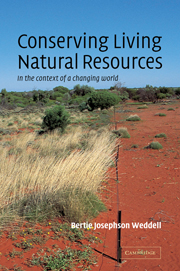Book contents
- Frontmatter
- Contents
- Preface
- Introduction: Balance and flux
- Methodology: Getting the information we need to manage living natural resources
- Part I Management to maximize production of featured species – a utilitarian approach to conservation
- Part II Protection and restoration of populations and habitats – a preservationist approach to conservation
- Part III Management to maintain processes and structures – a sustainable-ecosystem approach to conservation
- Postscript
- Appendix: Scientific names of organisms mentioned in the text
- Index
Introduction: Balance and flux
Published online by Cambridge University Press: 05 June 2012
- Frontmatter
- Contents
- Preface
- Introduction: Balance and flux
- Methodology: Getting the information we need to manage living natural resources
- Part I Management to maximize production of featured species – a utilitarian approach to conservation
- Part II Protection and restoration of populations and habitats – a preservationist approach to conservation
- Part III Management to maintain processes and structures – a sustainable-ecosystem approach to conservation
- Postscript
- Appendix: Scientific names of organisms mentioned in the text
- Index
Summary
Apart from the hostile influence of man, the organic and the inorganic world are… bound together by such mutual relations and adaptations as secure, if not the absolute permanence and equilibrium of both, a long continuance of the established conditions of each at any given time and place, or at least, a very slow and gradual succession of changes in those conditions. But man is everywhere a disturbing agent. Wherever he plants his foot, the harmonies of nature are turned to discords. The proportions and accommodations which insured the stability of existing arrangements are overthrown.
(Marsh 1874:34)This statement, by George Perkins Marsh – a nineteenth-century American diplomat, conservationist, and writer – expresses a concept that can be traced in western thought as far back as ancient Greece: the idea that nature in the absence of human intervention is in a state of balance which changes little over long periods of time. In the nineteenth century, this view became a credo for the young science of ecology.
The concept of balance figures so prominently in discussions about natural resource management that it is worth looking at in more detail. In scientific formulations, balance – or equilibrium – is defined as a state in which there is no net change in a system.
- Type
- Chapter
- Information
- Conserving Living Natural ResourcesIn the Context of a Changing World, pp. 1 - 8Publisher: Cambridge University PressPrint publication year: 2002
- 1
- Cited by



